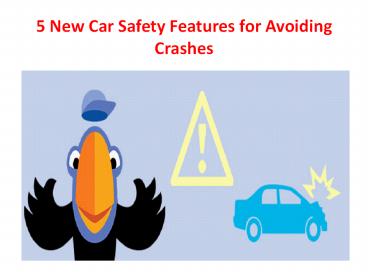5 New Car Safety Features for Avoiding Crashes - PowerPoint PPT Presentation
Title:
5 New Car Safety Features for Avoiding Crashes
Description:
Some forward collision warning systems vibrate the steering wheel to get your attention or even apply the brakes for you. The sensors in your car detect how close you are to other vehicles and stationary objects and then determine when you should brake. In other words, our cars are now making the roads a lot safer for us. – PowerPoint PPT presentation
Number of Views:184
Title: 5 New Car Safety Features for Avoiding Crashes
1
5 New Car Safety Features for Avoiding Crashes
2
See how the next-generation of car safety
features are helping to protect us on the
road. While vehicle safety may not be as sexy or
disruptive as other aspects of car technology,
auto manufacturers have continued to explore new
car safety features that can help protect
drivers, passengers and pedestrians alike. Even
though todays cars are already designed to
crumple around us, alert us to danger and save
lives with pillow-soft airbags, each year we're
seeing new innovative features and
improvements. Here's a list of next-generation
features that are helping drivers re-think
vehicle safety. 1. Forward Collision Warning One
of the most powerful car safety features
available today is forward collision warning.
Comprised of a system of radar sensors and
cameras, it scans the road ahead and warns you
with bright lights and loud noises if youre
about to hit something. Some forward collision
warning systems vibrate the steering wheel to get
your attention or even apply the brakes for you.
The sensors in your car detect how close you are
to other vehicles and stationary objects and then
determine when you should brake. In other words,
our cars are now making the roads a lot safer for
us. Keep in mind that external factors such as
snow, ice and even the sun can alter how this
feature works. Be sure to check your owners
manual for the location of your sensors so you
can keep them clean. Also, it goes without saying
that you shouldnt rely solely on the collision
system to avoid accidents, because the angle of
the sun during certain conditions might render it
less effective.
3
2. Rear-View Cameras This is one that's becoming
more and more commonplace. Projecting to a screen
in the cab, these cameras allow you see blind
spots when reversing. Many feature diagrammatic
indicators to show you how much room you have, as
well as warning lights or sounds to alert you
when you might be getting too close to an
object. Most rear-view cameras are manufacturer
installed, but you can also buy one as an
aftermarket upgrade if your car didn't come with
one. They come with several options and features
so you can tailor your camera and alerts to your
needs. 3. Lane Departure Warning Like the
forward collision warning system, this feature
allows us to monitor how well were staying in
our lane using lane-detection technology. If you
drift out of your lane, your car can alert you
with vibrations, audio or visual cues. Some can
automatically take steps to ensure you remain in
the proper lane. Like all automobile features,
you shouldnt rely solely on this system to
prevent accidents. Infrared sensors sometimes
fail, and these systems are reliant on lane
markings. This system might not decipher lane
markings which are damaged, obscured or faded.
4
4. Adaptive Headlights Adaptive headlights are
designed with a camera mounted in the grille of
the car that can scan the road ahead of us as we
drive. When it spots an obstruction in or along
the side of the road, the headlight points
towards the object or person, allowing you to
better spot trouble as you navigate the
darkness. Adaptive headlights have a limited
number of items they can track, but the camera
uses heat signatures to help find people and
animals and assigns priority to those first. This
system also assigns risk to these objects or
targets, picking out the highest risk to
spotlight. This technology can selectively adjust
or turn off LED lights, and it can maintain
high-beam lights - although it wont switch
automatically from low to high beams. While
adaptive headlights are available on many
vehicles, it hasn't yet become a standard
feature. 5. Adaptive Cruise Control This feature
uses lasers, radar, or cameras and on-board
sensors to adjust your vehicles speed in order
to maintain a safe distance from other vehicles.
With it, you can ensure a constant speed in
traffic without the annoyance of having to switch
your cruise control on or off. More importantly,
you'll ensure you remain a safe distance from
other vehicles.
5
Most adaptive cruise control systems are
comprised of a single radar system that only
detects traffic in front of you. Some of the more
complex and expensive systems have multiple
sensors to assist with short- and long-term
ranges as well as track adjacent vehicles. Some
adaptive cruise control systems have brake
support and pre-crash assistance to let you know
if theres a risk of a collision. Even more
advanced GPS assisted systems can tell if the car
in front of you is slowing down to change lanes
or exit, or just decelerating and then adjust
your speed accordingly. Conclusion Until the
self-driving car is a day-to-day reality, well
have to live with piloting our own vehicles. At
least we can be assured that decades of
technological advancements have helped build a
safer driving experience. Each year many of these
safety features become standard equipment on more
and more cars. Hopefully that translates to a
safer driving experience for all of us.































